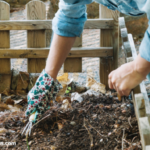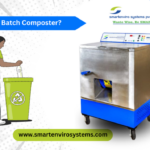Composting is an environmentally friendly practice that transforms kitchen scraps and yard waste into valuable, nutrient-rich soil for your garden. If traditional composting methods seem too cumbersome or slow, a drum composter could be the perfect solution. This guide will walk you through everything you need to know about drum composters, making the composting process simple and engaging.
What is a Drum Composter?
A drum composter, also known as a tumbling composter, features a rotating barrel mounted on a frame. This design allows the drum to be turned, mixing and aerating the contents easily. Unlike stationary compost bins, drum composters speed up the decomposition process significantly, thanks to their ability to maintain optimal conditions for microbial activity.
Why Use a Drum Composter?
1. Efficiency: Drum composters can produce usable compost much faster—sometimes in as little as a few weeks, compared to months with traditional methods.
2. Convenience: With a drum composter, you don’t need to manually turn the compost with tools. A few spins of the barrel do the job, mixing the organic material and providing necessary aeration.
3. Cleanliness: The enclosed design helps contain odours and keeps pests out, making it an excellent option for small spaces and urban settings.
4. Ease of Use: Drum composters are user-friendly, even for beginners. They’re designed to be straightforward to fill, turn, and empty.
Choosing the Right Drum Composter
Selecting the right drum composter depends on several factors:
1. Size and Capacity: Think about the amount of organic waste you generate. Drum composters can vary greatly in size, typically ranging from 60 to 200 litres. A larger household or one that gardens extensively might prefer a bigger model.
2. Material: Most are made from plastic or metal. Plastics are lightweight and resistant to corrosion, whereas metals are more durable but can be heavier.
3. Design Features: Consider models with features like dual chambers (allowing for continuous composting), internal mixing bars (for better aeration), and a robust frame (for easier turning).
4. Aeration and Drainage: Efficient composting requires good airflow and moisture control. Look for models with ventilation holes and drainage to manage excess moisture.
Setting Up Your Drum Composter
Setting up your drum composter is straightforward:
1. Location: Place it in a spot that’s both convenient for adding materials and suitable for temperatures; a bit of sunlight can help heat up the compost, speeding up the process, but too much might dry it out.
2. Starting Your Compost: Begin by alternating layers of ‘green’ materials (such as kitchen scraps and fresh garden clippings) with ‘brown’ materials (such as dry leaves, sawdust, or shredded paper). The ideal ratio is roughly 1 part greens to 3 parts browns.
3. Moisture Level: The compost should be moist like a wrung-out sponge. If it’s too dry, add water; if too wet, add more brown materials.
How to Use Your Drum Composter
1. Regular Turning: Turn the drum every two to three days to mix and aerate the compost. Regular turning is critical for oxygenation and to distribute moisture evenly.
2. Monitor Progress: Keep an eye on the decomposition process. The compost should be dark, crumbly, and have an earthy smell when ready.
3. Harvesting Compost: Once the compost looks ready, stop adding new materials and let the batch finish decomposing. You can then empty the composter machine and use the compost in your garden.
Maintaining Your Drum Composter
To keep your drum composter functioning optimally:
1. Clean Regularly: After emptying your composter, give it a rinse to remove any residual material, which can inhibit the next batch.
2. Check for Wear and Tear: Inspect the composting machine regularly for any signs of damage, especially if it’s plastic, as sunlight can make some plastics brittle over time.
3. Manage the Environment: In very wet or dry weather, adjust how you use your composter. Add dry brown material during wet seasons and water in dry spells.
Tips for Successful Composting
1. Chop or shred larger items: Smaller pieces decompose faster.
2. Avoid composting meats, oils, and dairy: These can attract pests and cause odour problems.
3. Balance is key: Adjusting the amount of greens and browns as necessary to keep your compost healthy.
4. Use mature compost as a starter: Adding a bit of finished compost to a new batch can introduce beneficial microbes that speed up the process.
Troubleshooting Common Issues
1. Bad Odours: If your waste composter starts to smell, it could be too wet or have too many greens. Balance it with brown materials and turn more frequently.
2. Slow Decomposition: If composting is slow, increase the temperature by adding more greens, ensure it’s moist, or turn the composter more frequently to reintroduce air.
Benefits of Using a Drum Composter
1. Reduces Waste: This organic waste converter helps divert waste from landfills, reducing your environmental footprint.
2. Creates Rich Soil: Use the compost to enrich your garden, improving soil structure, nutrient content, and plant health.
3. Teaches Responsibility: Managing a composter can be a great family activity and teaches everyone about sustainability.
Conclusion
Drum composters are an excellent investment for gardeners looking to reduce their environmental impact and produce their own compost. With minimal effort, you can turn kitchen scraps and yard debris into gold for your garden, improving your plants’ health and reducing waste.
Smart drum composter stands as an innovative solution for gardeners aiming to streamline their composting process while embracing environmentally friendly practices. This advanced machine integrates a shredding mechanism ideally positioned for ease of use, ensuring that organic waste is efficiently broken down before entering the composting phase.
Its design supports an odourless and silent operation, making it a neighbour-friendly choice in residential areas. The composting cycle completes within just 10 to 12 days, thanks to its efficient aerobic system that not only speeds up the process but also utilises the heat generated to evaporate excess moisture, leaving behind dry, ready-to-use compost.
Designed with the highest safety standards, this composter offers a comprehensive composting system encapsulated within a single, robust machine, providing an effortless, effective, and sustainable gardening tool.
Whether you’re a seasoned gardener or just starting, a drum composter is a simple and effective tool to add to your gardening arsenal. Happy composting!



